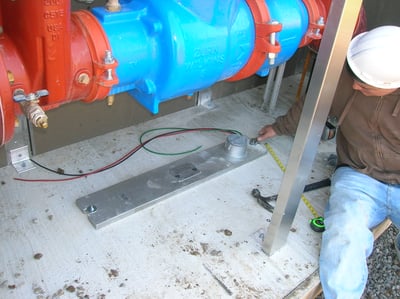One of the most overlooked forms of protection for a backflow assembly is the heating element within an enclosure. Regardless of where you are located in the United States, a backflow heating element is an essential component to preventing catastrophic failure as a result of freezing temperatures. Remember, 2021 featured freeze events in traditionally warm weather climates like Houston, TX and Miami, FL. No part of the continental United States can be considered immune from potential freeze conditions anymore.

As engineers and municipalities design to the trend and request more above-ground enclosures, they need to consider what type and size heating elements will be included. Let's take a look at different types of heating elements and heater design for backflow enclosures.
What Is a Backflow Enclosure Heating Element?
A heating element installed within an enclosure protects a backflow preventer from freeze and freeze-related damage. Heating elements vary, from wired heat trace or cable wrapped around a device, to heaters mounted on an enclosure's walls, to most effectively, slab-mounted heaters mounted at the lowest point of the enclosure, allowing rising heat to warm the entire space, including the piping and components inside and beneath. When combined with a properly insulated enclosure, the resulting effect is essentially double insulation. While types of heating elements vary, all intend to protect against water freezing inside the backflow device or the fittings around it.
What Are the Common Types of Backflow Enclosure Heating?
Heating Tape:
Self-regulating heat cables are wrapped around the backflow device and surrounding pipes. However, most enclosure product manufacturers only provide the heat cable option for small diameter installations. Heating tape is ineffective with larger diameters as the current passed through the cable isn't strong enough to adequately protect the water and equipment from potential freezing.
Wall Mounted Heater:
Wall-mounted heaters are the most common form of heating elements in backflow enclosures. They sufficiently keep surface temperatures of the air around a backflow assembly from getting too cold, and their high mounted location prevents relief valve discharge water from shorting out electrical components of heating elements. However, that same high mounted location within an enclosure will prevent the pipe risers and any components below the wall-mounted heater from being adequately heated and protected. As heat rises within the enclosure, the lower half of the enclosure -- as well as the pipes beneath it -- grows increasingly exposed to freezing conditions and increases the chance of freeze-related failure.
Slab-Mounted Heater:
This heating element, exclusively offered by Safe-T-Cover, is mounted directly to a concrete slab and heats the entire enclosure from the ground up. Not only is the slab itself heated, but the fan heater, riser pipes and all internal components are sufficiently protected from freezing conditions. Slab-mounted heaters are wet/damp certified and can be installed without the worry of water damage. The temperature gauge is mounted 12 inches above the slab and better maintains proper temperatures within the entire enclosure. This video on freeze protection gives a good overview of what makes a slab-mounted heater the best option.
What Type of Backflow Element Heater Is Best?
Slab-mounted heaters are the preferred type of backflow heating element and mainly what our designers recommend for our clients. When compared to the other options on the market, it's clear that our slab-mounted heater offers maximum protection against freezing conditions and equipment failure inside a Safe-T-Cover enclosure.
Safe-T-Cover offers 1000 and 2000 watt slab-mounted heaters, as well as 120 and 240 operating voltages. You'll need to ask your manufacturer for more information on enclosure heaters with higher voltages and to discuss your specific needs. You should set the thermostat for wall- or slab-mounted heaters at 40℉ and the heater will maintain this temperature all the way down to -30℉.
Still Not Sure What Heating Element is Best?
We've put together an informative video on the best solutions for heating your enclosure and ensuring that your backflow device is protected from the elements.
FAQs About Enclosure Heaters
How do enclosure heaters work?
Enclosure heaters operate similar to central heating inside any building: with a thermostat preset to a designated temperature, the heater will activate once the temperature inside the enclosure reaches that threshold. For efficiency and added protection, it's important that the enclosure not only has adequate heat, but insulation that helps retain heat and sustain temperatures for proper equipment function.
How do you size an enclosure heater?
The enclosure manufacturer should provide you with recommendations for appropriate heating options, size and wattage/voltage. Any heater should meet ASSE 1060 Class I standard and UL 2021 certified. For Safe-T-Cover enclosures, our design experts will gladly provide you with the most suitable option for your situation.
What is the recommended heating setpoint?
Heaters should be set at 40ºF to maintain appropriate conditions within the enclosure when exterior temperatures fall as low as –30ºF.




